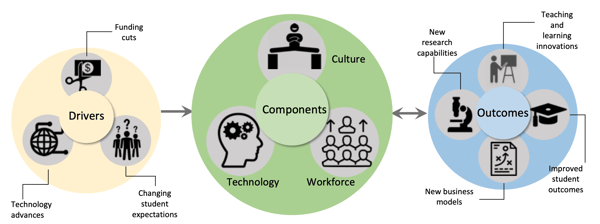Published on
How Student Expectations Are Driving Digital Transformation

Higher education is experiencing a set of pressures, challenges and opportunities that will change it forever. Information technology is helping to both drive and enable a digital transformation in our industry.
EDUCAUSE calls higher education’s digital transformation “Dx” and defines it as “a cultural, workforce, and technological shift.” The IT industry is being driven by technology trends and changes that are enabling a new approach to everything from digital architectures to how campus leaders interact with the IT organization. These new approaches will generate new opportunities and outcomes, notably, improved student success, innovative teaching and learning methods and new research capabilities. The transformation of our core missions will enable, if not require, institutions to develop entirely new business models.
Changing student expectations are a key driver of higher education’s digital transformation. In particular, students want a customer experience that is personalized and seamless. They want a home base for their education, but they want their institution to offer access to a larger higher education marketplace. They want to be at a competitive advantage when they graduate, and that means having job-ready skills and competencies and new and innovative learning opportunities.
Personalized Experience and Seamless Interfaces
Today’s best applications and systems focus on optimizing the user experience. A growing number of institutions (37 percent in 2018) are incorporating user-centered design into their IT strategy.[1] Students want easy-to-use applications. They also want applications that give them personalized advice. A new generation of student success solutions is helping students plan and track their academic success, and students are enthused about them. EDUCAUSE research has found that 70 percent of students find degree audit tools that show the degree requirements completed very or extremely usefuland 67 percent of students find degree planning or mapping tools that identify they coursestheyneedto complete theirdegree very or extremely useful.[2]
A Higher Education Marketplace
Students are not as tethered to a single institution as they used to be, and institutions are responding with access to a larger marketplace and options to help students navigate that marketplace. The California Community College system has opened the California Virtual Campus , a kind of digital marketplace that offers 2.1 million students from 114 campuses the ability to take any of those institutions’ online courses, and to easily transfer credits from other colleges in the Virtual Campus. This level of cross-institutional collaboration didn’t happen overnight. Institutional leaders began by establishing ground rules, identifying common business processes for student services like financial aid and admissions, and standardizing on a shared course management system. Students love this kind of flexibility and access: EDUCAUSE research shows that 59 percent of students find self-service systems for tracking credits, credit transfers and dual enrollment very or extremely useful.[3]
Technology can facilitate students’ movement throughout the higher education marketplace. MIT has developed a digital diploma using Blockcerts, based on Bitcoin’s blockchain technology. Their digital diploma gives studentsautonomy over their own recordsand may eventually incorporate stackable certificates to link credentials from different institutions.
Job-Ready Graduates With A Competitive Advantage
While a degree in philosophy or comparative literature equips students with invaluable critical thinking skills and other competencies useful in life and in the workplace, many students may still graduate lacking some very specific skills that particular employers require. To help their students (and faculty, staff and alumni), Duke University is supplementing its campus-based courses with free access to Coursera for Duke, an online, self-paced, non-credit learning experience that offers the Duke community the ability to earn Coursera certifications for career-relevant skills like image and video processing, inductive reasoning, and statistics. Boston University has institutionalized academic innovation by forming the Digital Learning and Innovation department led by a new Associate Provost position. The department consists of three teams:A pedagogy team, which advises individual faculty and graduate students on course design and innovative teaching practices; A technology team, which provides support for instructors in the use of digital learning technologies; and the Digital Education Incubator, which supports innovative approaches that add value through technology by funding and co-managing pilot projects. HP is funding an XR initiative with EDUCAUSE and 11 colleges to develop and document innovations in teaching and learning powered by XR technologies like mixed and augmented reality and 3D printing.[4]Faculty are able to teach in previously impossible ways that give students immersive experience with long-lost cultures, physically inaccessible environments, and events they might not otherwise have access to. Students and faculty alike are developing new insights and ways of framing and solving problems.
Higher education’s digital transformation is just beginning. Institutions that develop a strategy for digital transformation will transform more than their technology interfaces, more than their business processes, more, even than the student experience. These institutions will find themselves able to adopt entirely new business models, models that offer credentials beyond today’s degrees, models that serve more diverse kinds of students, models that operate within a highly complex marketplace of life-long education and learning. Those new business models will also remake research and scholarship to meet our world’s changing needs for knowledge creation and transfer.
No one can predict what will change, what will be lost or gained. Now, the beginning of our digital transformation, is the time to pay attention, to ask questions and to anticipate and respond to the developments that answer them. Here are some questions I’m pondering:
- Will our transformation be coopted and dominated by competition, or will cooperation, openness and collaboration remain a defining part of our culture?
- Will a mass consolidation of institutions occur, resulting in a marketplace that looks more like Amazon than Etsy?
- Will the tight coupling of research and scholarship with teaching and learning continue to be a hallmark of higher education?
- Will alumni dedication (and giving)—the brand loyalty of higher education—give way to detached self-interest and impatience for what’s cheap, novel and fast?
As our digital transformation progresses, we may very well lose much of what is familiar and even precious about our sector. But we all have influence over what happens, if we are engaged, hopeful and know the outcomes we believe are best. Our engagement—your engagement—is what’s needed if we are to retain and remake a vibrant, resilient, relevant industry and profession that keeps pace with the demands, challenges and opportunities of the 21st-century.
– – – –
References
[1] EDUCAUSE, “Higher Education’s 2019 Top 10 Strategic Technologies and Trends” (forthcoming).
[2] Joseph Galanek, Dana C. Gierdowski, D. Christopher Brooks, “2018 Students and Technology Research Study.” EDUCAUSE. October 2019. https://library.educause.edu/resources/2018/10/2018-students-and-technology-research-study
[3]Ibid
[4] Jeffrey Pomertantz, “Learning in Three Dimensions: Report on the EDUCAUSE/HP Campus of The Future Project.”EDUCAUSE. July, 2018. https://library.educause.edu/resources/2018/8/learning-in-three-dimensions-report-on-the-educause-hp-campus-of-the-future-project
Author Perspective: Association




